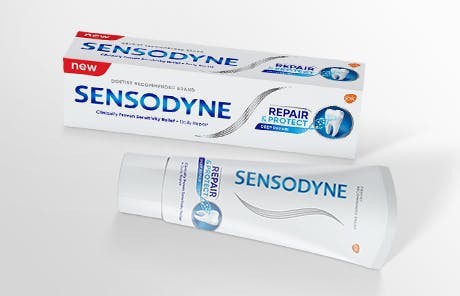Receding Gums: Causes and Prevention
Good oral health isn’t simply about keeping your teeth clean. Taking care of your gums is just as important when it comes to making sure your smile is free from pain or worry.
Gum recession is one of the most common causes of tooth sensitivity. When we suffer from receding gums, the soft dentine inside the tooth can become exposed. Dentine is full of tiny holes that lead directly to the nerve at the centre of the tooth. This is why you might experience the nasty twinge of sensitivity pain when you take a sip of ice-cold water, enjoy a hot cup of tea or bite into something sweet or sour.
In this no-nonsense guide we help you understand what causes receding gums, the best way to tackle receding-gum pain and how to prevent gum recession.
WHAT CAUSES RECEDING GUMS?
Understanding what causes gum recession is the first step in learning how to treat and prevent receding gums.
A receding gum line often happens gradually, meaning that it can be difficult to spot. When brushing, keep your eye out for any redness, bleeding or swelling. There are several reasons why you might experience these symptoms. Some of the most common include:
- Not brushing your teeth properly or regularly. Poor oral hygiene can lead to a build-up of plaque, a sticky film containing bacteria that can harm your gums. This often leads to gum diseases such as gingivitis and the more serious periodontitis, which affects the tissue and bone that supports your teeth.1,2
- Overbrushing.3 Cleaning your teeth too vigorously or using a toothbrush with very hard bristles can cause your gums to recede.
- An old toothbrush. Replace your brush every three to four months, and make sure it is kept clean and dry between uses.4
- Smoking. This can both cause gum disease and make it worse.5
- People who are pregnant or who suffer from diabetes or a weakened immune system are more at risk of receding gums.6
HOW TO PREVENT RECEDING GUMS
Sadly, once gums have receded, they can’t grow back. The great news is that a good oral-hygiene routine can help prevent further gum recession and reclaim your pain-free smile.
In the long term, we recommend going for dental check-ups every one to two years, though you may need to visit your dentist more frequently if you’re experiencing problems or suffer from a condition that makes you more susceptible to gum recession. Dentists or dental hygienists can help you master your oral-care routine and spot the signs of receding gums. The sooner it’s treated, the better.7,8
There are simple steps you can take at home too. Brush your teeth regularly, at least twice a day, and use a toothpaste containing fluoride.
If you suffer from short, sharp toothache, consider using a toothpaste designed to tackle tooth sensitivity, such as the dual-action Sensodyne Sensitivity & Gum toothpaste, which builds a protective layer over sensitive areas while removing plaque and bacteria to support gum health.9 Use this with the Sensodyne Repair & Protect Toothbrush to prevent overbrushing while cleaning effectively. Sensodyne Rapid Relief has been proven to relieve sensitivity in just 60 seconds.
To put the pleasure back into pain-free eating and drinking, explore the full Sensodyne range, including toothpaste for receding gums, and find out which one is best suited to you.
Sources: Clicking any of the links below takes you to an external website that is independently operated and not managed by Haleon. Haleon assumes no responsibility for the content on the website. If you do not wish to leave this website, do not click on the links below.
- Gum Disease, NHS Direct Wales. https://www.nhsdirect.wales.nhs.uk/encyclopaedia/g/article/gumdisease; Accessed 18/02/2020. Referenced text is highlighted in source PDF.
- Gum Disease, NHS Direct Wales. https://www.nhsdirect.wales.nhs.uk/encyclopaedia/g/article/gumdisease; Accessed 18/02/2020. Referenced text is highlighted in source PDF.
- Receding Gums: Treatments And Causes, NetDoctor.co.uk. https://www.netdoctor.co.uk/conditions/mouth-and-teeth/a24781365/receding-gums-treatment-and-causes/; Accessed 18/02/2020. Referenced text is highlighted in source PDF.
- How To Keep Your Teeth Clean, NHS. https://www.nhs.uk/live-well/healthy-body/how-to-keep-your-teeth-clean/; Accessed 18/02/2020. Referenced text is highlighted in source PDF.
- Bad Breath, NHS. https://www.nhs.uk/conditions/bad-breath/; Accessed 18/02/2020. Referenced text is highlighted in source PDF.
- Gum Disease, NHS. https://www.nhs.uk/conditions/gum-disease/; Accessed 18/02/2020. Referenced text is highlighted in source PDF.
- Gum Disease, NHS. https://www.nhs.uk/conditions/gum-disease/; Accessed 18/02/2020. Referenced text is highlighted in source PDF.
- Diabetes and Gum Disease, Diabetes UK. https://www.diabetes.org.uk/guide-to-diabetes/complications/gum-disease; Accessed 18/02/2020. Referenced text is highlighted in source PDF.
- Periodontal Health For A Better Life, British Society of Periodontology. https://www.bsperio.org.uk/assets/downloads/Patient_Information_Leaflet.pdf; Accessed 18/02/2020. Referenced text is highlighted in source PDF.








